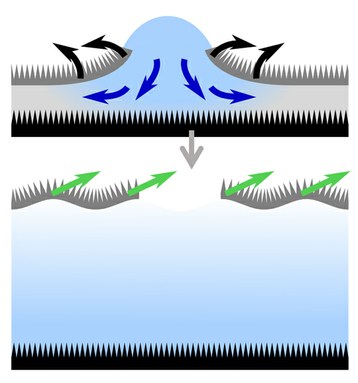Brave new layer
Freiburg, Jul 07, 2017
Nature is able to take just a few building blocks to whole microworlds with astonishing effects. The lotus plant for example has a surface which water and dirt simply roll off - a phenomenon long since copied by research and industry. But the effect only works if the surface is free of tears and scratches. Freiburg researchers aim to make it more resistant. The team drew inspiration from snakes; they simply shed their skins when they no longer need them.

Sly snake - Reptiles simply shed their skins when they no longer need them - this mechanism was an inspiration to the researchers. Photo: lunatic67/Fotolia
When Jürgen Rühe went to buy paint for a big painting job at home, the salesman advised him not to buy the paint with the lotus effect. “I was very surprised,” Rühe remembers. He is Professor of the Chemistry and Physics of Interfaces at the University of Freiburg’s Department of Microsystems Engineering (IMTEK). “After all, the water-repellent effect of the lotus is well known.” The paint specialist told the microsystems engineer that the principle works fine as long as the surface is intact. Droplets roll down the painted wall and take the dirt with them. But as soon as a scratch gets in the way, the droplets and their dirt get stuck. Not pretty. That caught Rühe’s attention.
A sip of fog
Getting ideas from nature is nothing new for Jürgen Rühe and his colleagues. They call it “bioinspiration.” For instance they copied one technique from the Stenocara beetle; it can be used to gather water from desert fogs. The beetle has no choice but to get the water it needs from the fog. To this end, it has an ultra-water-repellent layer on its body. As soon as the morning mist creeps over the dunes, the beetle does a headstand and collects the tiny droplets.
They roll down the water-repellent surface but stop at several water-attracting spots. As soon as a drop is big and heavy enough, it breaks away and flows over the water-repellent surface and into the beetle’s mouth. “With the help of micro- and nano-structuring we simply reproduced it and got an artificial surface we can use to condense water out of fog,” says Rühe.

Water and dirt roll off lotus leaves - but the effect only works if the leaf’s surface is undamaged. Photo: Cooperr/Fotolia
That “simple reproduction” means you have to understand highly complex structures. Nature is able to take just a few building blocks to whole microworlds with astonishing effects. Brightly-colored petals and butterfly wings sometimes contain no colouring agent; they create color effects solely by the arrangement of various structures. “It’s incredibly inspiring,” says Rühe; “we want to use effects like that too.” For example to make the rather practical lotus layer tougher. Demand is high, water-repellent materials are needed - for rain gear, teflon pots and pans, waterproofing in industry.
Cones and grass
The researchers have combined nano and micro structures - the first look like a big field of grass, the other like tiny hills with pointy peaks. “If a drop of water or a rough finger touches the nanograss, the individual grass stems quickly fold and can no longer do their job,” Rühe explains. But the cones are considerably higher than the grass. If such a structure is subject to mechanical force, the top of the cone may break off, but the overall surface will continue to function. The researchers have managed to make the lotus surface more stable thanks to the new combination; this kind of solution is conceivable now even for metal surfaces. An IMTEK doctoral student is working on that.
“But even the strongest surface is no good if the force acting on it is too strong,” Rühe says. “A scratching key for instance is too much for any synthetic surface we have so far.” So creating a more stable coating is merely the first line of defense. The second line of defense is another one the researchers copied from nature. It doesn’t have a fix-it service. If the damage is too much, it gets rid of the damaged layer. Worn-out leaves are shed.

The new level consists of nano and micro structures - the first look like a big field of grass, the other like tiny peaks with pointy tops. If you combine the two structures the surface becomes more stable. Source: Jürgen Rühe/University of Freiburg
Like a parquet floor
“For animals it’s a bit harder. They can’t just do without a leg.” Snakes and lizards among others have a mechanism which the Freiburg researchers would like to transfer to the lotus surface - the ability to shed worn-out skin. The idea is simple. If the outer, water-repellent layer is damaged, it is sloughed off and a new, fully functional layer with the same characteristics appears. To do this, they stuck another layer made of water-soluble polymers in between the two water-repellent ones. Rühe calls it the “sacrificial layer.” If the outermost layer is damaged, the water gets in through the scratches and reaches the sacrificial layer. It begins to dissolve. That removes the outer layer, revealing the undamaged layer underneath. The water can roll off undisturbed again, taking all the dirt with it.
“In this way we have doubled the hydrophobic - that is water-repellent - effect,” says Rühe. Theoretically you could repeat it, alternating three or more layers with “sacrificial” layers, he says. And to stop the entire layer coming off every time, the researchers plan to stick it on in compartments - like a parquet floor. Then the surface would only renew itself in the area which was damaged. “We don’t yet know how good it will look, but that is the next question. Our first concern was the duration of the material.”
Claudia Füßler
Jürgen Rühe’s research at the University of Freiburg
http://www.cpi.uni-freiburg.de
The group members explain their work in a video.
https://www.cpi.uni-freiburg.de/news/snakeskin-pressrelease

